by Kate Stafford and Mark Richardson
There’s little mystery to successfully establishing plants in the landscape. Most plants will thrive when given the right growing conditions. But, it’s our job as landscape professionals to provide all the tools for their success – from choosing the right plants for the site and digging properly-sized holes, to proper post-planting care.
Unfortunately, despite our best efforts, failure sometimes happens for reasons we cannot always understand, and as much as we often want to blame them, it’s not the plant’s fault if it dies. Assuredly, everything you’ve ever planted would prefer survival over the alternative if it had the capacity to choose. When plants fail, there always is a reason; by that logic, there always is a solution that could have prevented the failure.
Choosing the Right Plants
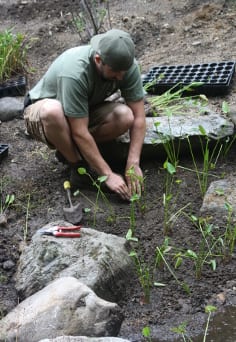
Garden in the Woods’ Coastal Sand Plain habitat garden features plants suitable for the coarse, sandy soil.
The old mantra “right plant right place” is deeply embedded in New England Wild Flower Society’s approach to sustainable horticulture. For Garden in the Woods, many of our gardens are habitat-based, and reflect plant communities found throughout New England. This also means that when we’re modifying or building gardens, we’re thinking first about existing environmental conditions and choosing a plant community that is most likely to succeed. In other words, rather than modifying the conditions to suit the garden we want, we build a garden that best suits existing conditions.
The best recent example of this approach is the Coastal Sand Plain habitat garden we built in 2013. The soil in this garden had been previously modified in the hopes of better suiting the xeric plants that composed the old Western Plant Collection that existed here. As a result, the soil profile is up to 24” of coarse, sandy soil above wetland soils and a very high water table. The resulting condition was one with low-fertility, well-drained, yet constantly moist soils and conditions that were well-suited to several coastal plant communities, including pitch pine/scrub oak, juniper maritime forest, and coastal sandplain grassland. We designed a garden that reflected these natural communities, and chose plants that would both thrive in the conditions present, and help interpret our mission to conserve and promote the region’s native plants to ensure healthy, biologically diverse landscapes.
Beyond choosing the correct species, we emphasized growing and/or purchasing plants from reputable nurseries with a strong record of producing healthy plants with vigorous root systems.
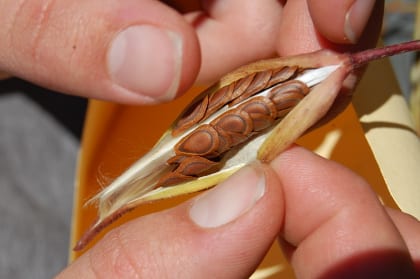
Asclepias incarnata : Collecting swamp milkweed (Asclepias incarnata) seeds from a wild population in Franklin County, MA. The seeds are hand-stripped from the pods in the field before the floss has dried and expanded. Photo by Kate Stafford
Growing Perennial Plugs from Seed
At Nasami Farm Native Plant Nursery we propagate native plants from local seed. This is a lengthy process that requires scouting for populations, acquiring land-owner permission, collecting seed sustainably and at the right time, and cleaning, processing and storing the seed. Additionally, most native seed has some dormancy in place to ensure that its progeny germinates at the right time of year, usually in spring, for reproductive success. To break seed dormancy in the nursery we use some specialized techniques but above all it requires time.
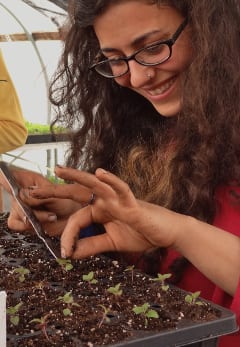
A volunteer transplants wild bee-balm (Monarda fistulosa) seedlings into a plug tray. Photo by Cayte McDonough
Once we have germinated seed we produce well-developed plugs by employing good growing practices. In addition to appropriate soil mixes, watering, and fertilizing regiments, we use the appropriate container for the plant. Deep plugs are well suited for planting directly into the ground because they provide space for plants to establish healthy root systems. We grow most trees and shrubs in RootMaker® brand root pruning plugs to produce a healthy root structure for a long-lived plant. We use a robust biological control program to keep pests and disease in check while producing a pesticide-free product.
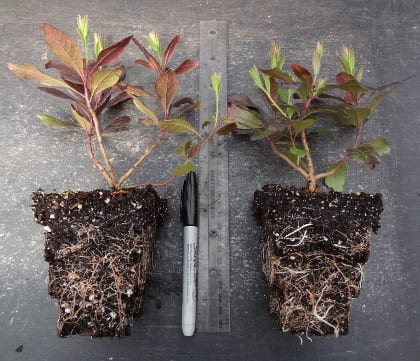
Nasami_RM: Bayberry (Morella caroliniensis) grown in RootMaker® brand root pruning plugs exhibiting beautiful root structure. Photo by Cayte McDonough
Our methods take longer and require highly trained staff. Why don’t we just vegetatively propagate plants from cuttings or tissue culture like most other nurseries? A plant that is vegetatively propagated is an identical copy of the stock it was grown from, whereas a plant grown from seed ensures some level of genetic diversity. Genetic diversity within a plant population is a key aspect of promoting healthy, biologically diverse landscapes. It is not only about what native plant to install where, it’s also about how that native plant was produced in the nursery. A plant that is grown from local seed collected from a large, robust population ensures the best genetic diversity and adaptations to local conditions.
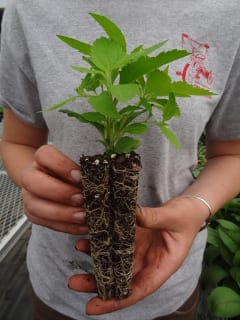
A well established landscape plug of spotted Joe-Pye weed (Eutrochium maculatum) is ready to be installed in the landscape. Photo by Cayte McDonough
Root Ball Treatment Prior to Planting
We have found that the best way to ensure good establishment of nursery stock, regardless of whether a plant is container-grown or balled-and-burlapped, is to inspect the root ball and address any structural root deficiencies at planting time. Common deficiencies like circling roots, plants that are at an improper soil depth, or girdling roots are best addressed prior to establishment, but can require dramatic steps to remedy. At times, this can mean completely removing all soil from a root ball prior to planting, shaving the outer edge of a root ball to address circling roots, and almost always means removing significant amounts of soil from the top surface of a root ball to expose the root flare. A little time spent correcting root deficiencies at time of planting is a wise investment for the successful establishment of a plant in the landscape.
Post-planting Care
The most limiting factor for successful establishment of plants in the landscape is water. As a result, we pay careful attention to and invest a lot of time and energy watering to establishment. This means heavy watering two to three times per week for the first month after planting, and at least once per week thereafter for the remainder of the growing season. Plants often are watered in with compost tea to rapidly introduce soil microbes that help aid in nutrient and water absorption.
Successful plant establishment isn’t rocket science, but it depends upon careful attention to detail when propagating and selecting plants, correcting root system deficiencies at time of planting, and post-planting care.
About the Authors
Mark Richardson oversees the New England Wildflower Society’s botanic garden, Garden in the Woods, and its native plant nursery operation, Nasami Farm in Whately, Massachusetts. He studied ornamental horticulture at University of Rhode Island and helped run a mid-sized ornamental plant nursery before finding his true passion in public horticulture. He led undergraduate programs at Longwood Gardens, overhauled the curriculum of the Professional Gardener Program, and oversaw adult education at Brookside Gardens. In 2013, Mr. Richardson assisted with the development of the first comprehensive master plan for Garden in the Woods. He holds a MS from the University of Delaware’s Longwood Graduate Program.
Kate Stafford is Nursery Operations Manager and Propagator at Nasami Farm. Working at the Society’s Nasami Farm in Whately, MA, Kate Stafford focuses on growing the region’s native plants from wild-harvested, sustainably collected seed. Kate also runs the nursery volunteer program, teaches courses, and writes articles. She has a profound interest in plant communities and the life they support. She received a BS in Biology from the University of Massachusetts.

